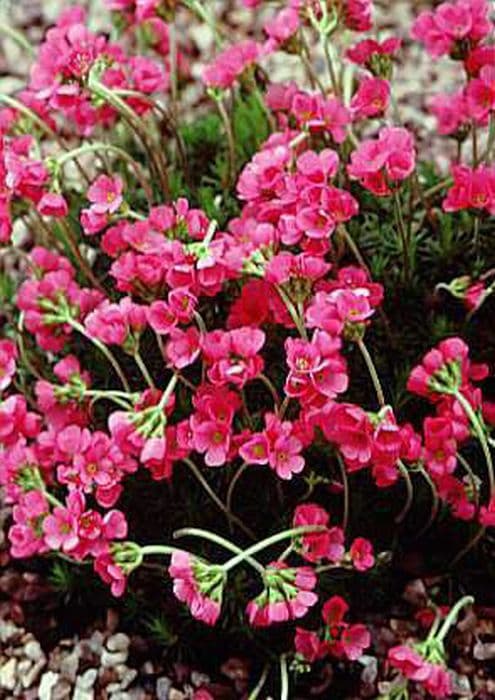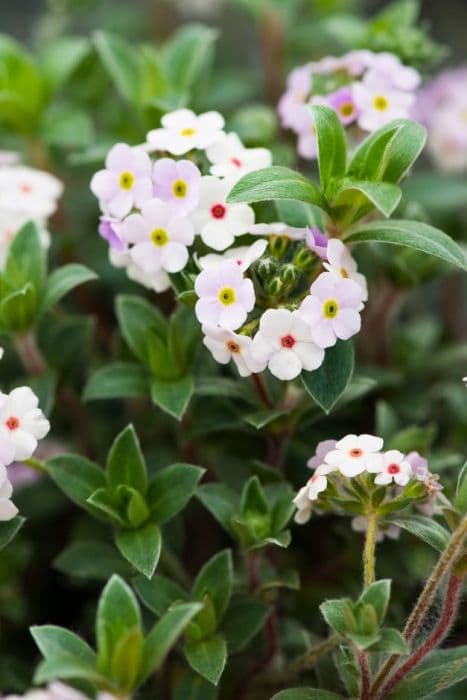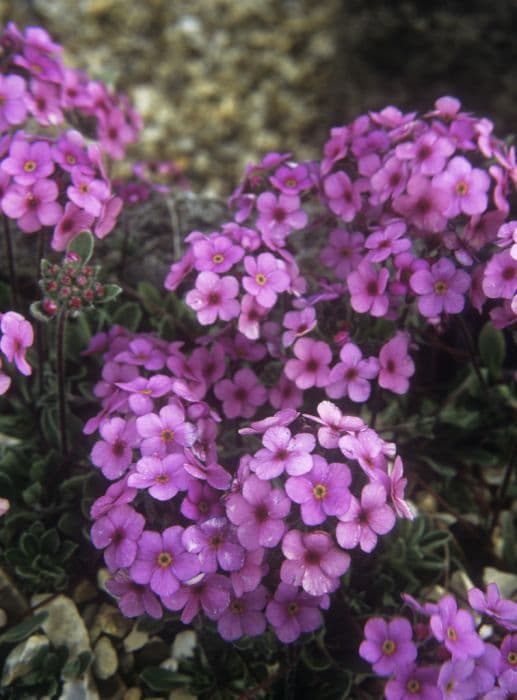Japanese Primrose Primula sieboldii f. lactiflora (Co)

ABOUT
Primula sieboldii f. lactiflora, commonly known as the Japanese primrose, is a captivating perennial that boasts a lush foliage of deep green leaves with a rounded to heart-shaped appearance and jagged edges. This provides a verdant backdrop to its distinct blooms. The flowers of the Japanese primrose are particularly striking, with delicate, rounded petals arranged in a whorl. These petals exhibit a soft hue, mostly creamy white, adding to the plant's gentle appearance. The flowers are carried on slender stems that rise above the foliage and gracefully nod, providing a sense of movement. The plant exudes a natural elegance and simplicity that could easily become the highlight of any garden collection.
About this plant
 Names
NamesFamily
Primulaceae.
Synonyms
Japanese Primrose, Siebold's Primrose, Geisha Girl.
Common names
Primula malacoides f. lactiflora, Primula poissonii f. lactiflora.
 Toxicity
ToxicityTo humans
Primula, commonly referred to in this context, is generally considered non-toxic to humans. While some Primula species can cause mild irritation if handled, particularly due to the presence of primin – a compound found in the plant's sap – Primula sieboldii f. lactiflora is not known to be poisonous if ingested. Therefore, it is not expected to cause serious symptoms of poisoning. However, as with any plant, individual allergies or sensitivities could result in mild symptoms if the plant, or its sap, comes into contact with sensitive skin or is ingested. These symptoms might include gastrointestinal discomfort or dermal reactions, but significant toxicity is unlikely.
To pets
Primula, in the context of pets, generally poses little to no toxicity risk. There are no widely recognized reports of Primula sieboldii f. lactiflora causing toxic effects in pets. If a pet were to ingest parts of this plant, the most likely outcome would be mild gastrointestinal upset. In sensitive individuals, this could involve symptoms like vomiting or diarrhea, but the plant is not known to cause severe poisoning or life-threatening symptoms in pets. As always, it's recommended to monitor pets to ensure that they do not consume plants that are not part of their typical diet, as even non-toxic plants can cause stomach upset or other issues in pets.
 Characteristics
CharacteristicsLife cycle
Perennials
Foliage type
Deciduous
Color of leaves
Green
Flower color
Varies
Height
0.5 feet (15 cm
Spread
0.5 feet (15 cm
Plant type
Herb
Hardiness zones
6
Native area
Asia
Benefits
 General Benefits
General Benefits- Aesthetic Appeal: Primula sieboldii f. lactiflora, commonly known as Japanese Primrose, provides vibrant blooms in shades of pink, white, and purple, creating an attractive display in gardens and natural settings.
- Habitat Enrichment: It offers habitat and nourishment for beneficial insects and pollinators like bees and butterflies, promoting a healthy and diverse ecosystem.
- Low Maintenance: Japanese Primrose typically requires minimal care once established, making it a convenient choice for gardeners of various skill levels.
- Seasonal Interest: With its spring flowering season, it adds seasonal interest to gardens, signaling the end of winter and the start of a lush growing season.
- Shade Tolerance: Well-suited for shaded areas, it provides color and greenery in parts of the garden where many other plants may not thrive.
- Soil Erosion Control: Its root system helps to stabilize soil, reducing erosion in sloped or vulnerable areas of the landscape.
- Cultural Significance: Japanese Primrose has cultural importance in Japan and can bring an element of traditional Japanese gardening aesthetics into diverse garden settings.
- Companion Planting: It can be planted alongside other shade-loving perennials to create a varied and textured garden bed.
- Breeding and Variability: The species is known for its variety of forms and cultivars, offering great potential for breeding and propagation.
 Medical Properties
Medical PropertiesThis plant is not used for medical purposes.
 Air-purifying Qualities
Air-purifying QualitiesThis plant is not specifically known for air purifying qualities.
 Other Uses
Other Uses- Primula sieboldii, also known as Japanese primrose, can be used for ornamental purposes in shaded rock gardens to create natural-looking landscapes.
- The flowers of Japanese primrose can be crystallized and used as elegant edible decorations on cakes and desserts.
- The leaves of the plant are occasionally used in the art of plant pressing where they are preserved for their intricate vein patterns and unique shapes.
- Japanese primrose plants can be grown in containers on balconies or patios where the ground soil is not suitable for planting.
- Because of its vibrant blooms, Japanese primrose can be used in floral arrangements, particularly in spring-themed bouquets.
- The plant can be part of a butterfly or bee garden, as it attracts pollinators when in bloom.
- Japanese primrose can be implemented in the study of phenology, which observes the timing of floral events and their correlation with climate change.
- As a subject for botanical illustration or photography, Japanese primrose provides a vibrant and delicate subject matter for artists and photographers.
- The flowers can be used in educational settings such as schools or botanical gardens to teach about plant biology and diversity.
- Cultivars of Japanese primrose can sometimes be used in breeding programs to create new varieties with unique characteristics.
Interesting Facts
 Feng Shui
Feng ShuiThe Japanese Primrose is not used in Feng Shui practice.
 Zodiac Sign Compitability
Zodiac Sign CompitabilityThe Japanese Primrose is not used in astrology practice.
 Plant Symbolism
Plant Symbolism- Hope: Primula sieboldii f. lactiflora, commonly referred to as Japanese Primrose, often symbolizes hope due to its early spring bloom, signifying the end of winter and the start of new growth.
- Youth: The plant's delicate and youthful flowers embody the essence of youth and freshness, making it a symbol of young love and life's beginning stages.
- Vitality: The vibrant colors and vigorous growth of the Japanese Primrose are seen as a representation of vitality and the rejuvenating energy of nature.
 Water
WaterThe Japanese Primrose needs to be watered regularly to keep the soil consistently moist but not waterlogged. It prefers a gentle watering method, such as using a watering can with a fine spray, to avoid disturbing the delicate flowers and foliage. The amount of water may vary depending on climate conditions, but generally, giving the plant about 1 inch of water per week should suffice. During hot or dry spells, the watering frequency should be increased, ensuring that the top layer of soil doesn't dry out completely between waterings. During the winter months, water sparingly, just enough to prevent the soil from drying out completely.
 Light
LightJapanese Primrose thrives in partial shade to full shade conditions. It is best to place the plant in a location that offers morning light but is shielded from the intense afternoon sun. An ideal spot would be under tree canopies or on the north side of buildings where it can receive natural, diffused light without being exposed to harsh direct sunlight. These lighting conditions help the flowers retain their vibrant colors and prevent the leaves from scorching.
 Temperature
TemperatureJapanese Primrose prefers cooler temperatures and can survive a range of conditions. The plant tolerates minimum temperatures down to about 20 degrees Fahrenheit, making it suitable for growing in regions with colder winters. Optimal growth occurs when daytime temperatures are between 60 and 75 degrees Fahrenheit. Japanese Primrose may go dormant if the temperature exceeds 80 degrees Fahrenheit, at which time it requires less water.
 Pruning
PruningPrune the Japanese Primrose after blooming to encourage a tidy appearance and promote healthy growth for the next season. Deadhead spent flowers regularly to prevent the plant from wasting energy on seed production. In late fall or early winter, remove dead or dying leaves to maintain good air circulation and reduce the risk of disease. Pruning is best done with clean, sharp scissors or pruning shears to minimize damage to the plants.
 Cleaning
CleaningAs needed
 Soil
SoilJapanese Primrose prefers a soil mix that retains moisture but is well-draining with rich organic matter. A blend of two parts peat, one part perlite, and one part compost works best. The ideal pH range is neutral to slightly acidic, around 6.0 to 7.0.
 Repotting
RepottingJapanese Primrose should be repotted every 1-2 years to refresh the soil and accommodate root growth. It's best done after flowering or in early spring before new growth begins.
 Humidity & Misting
Humidity & MistingJapanese Primrose thrives best at higher humidity levels, ideally between 50% to 70%. Avoid dry air, which can cause the foliage to become crisp.
 Suitable locations
Suitable locationsIndoor
Place in bright, indirect light with high humidity.
Outdoor
Partial shade, moist soil; protect from afternoon sun.
Hardiness zone
4-8 USDA
 Life cycle
Life cycleThe life of a Japanese Primrose, Primula sieboldii f. lactiflora, begins with seed germination, which requires a period of cold stratification to break dormancy. Upon sprouting, the plant develops a basal rosette of leaves and, given appropriate conditions of moisture and light, will grow to maturity typically within a year. Once mature, Japanese Primrose produces clusters of delicate, frilly flowers in various shades of white and pink, blooming mainly in spring. After pollination by insects, the flowers will set seed, which are then dispersed by wind or water, or simply drop to the ground to potentially grow into new plants. During the summer, after the bloom has faded, the plant's foliage dies back and it enters a period of dormancy, with the roots remaining alive underground. The following spring, the cycle begins anew as new shoots emerge from the surviving rootstock, given that the plant is a perennial.
 Propogation
PropogationPropogation time
Spring-Early Summer
The most popular method of propagation for the Japanese Primrose, Primula sieboldii f. lactiflora, is through division. The best time to divide this plant is in the early spring or after the blooming period in late spring to early summer. To propagate by division, carefully dig up the clump of the primrose when the plant is not in active growth. Gently separate the roots into smaller sections, ensuring that each new piece has several healthy leaves and a portion of the root system. Replant the divisions immediately, maintaining the same planting depth as the original plant, and water thoroughly. A general rule of thumb is to space the divisions about 6 to 12 inches apart (approximately 15 to 30 centimeters), which allows sufficient room for growth. With proper care, these divisions will establish and grow into blooming plants within a season.









